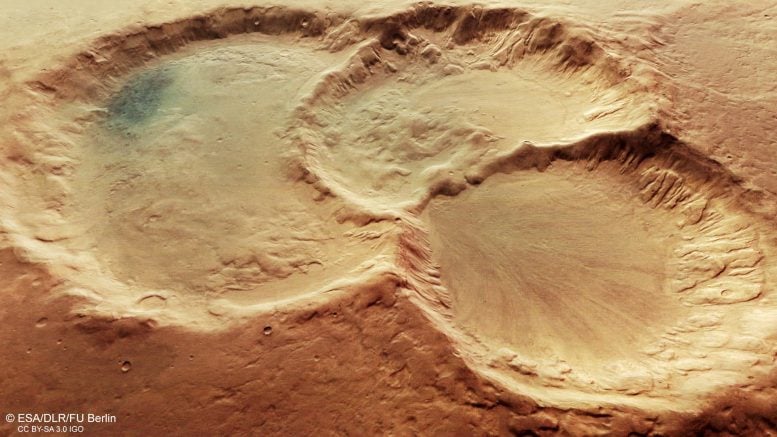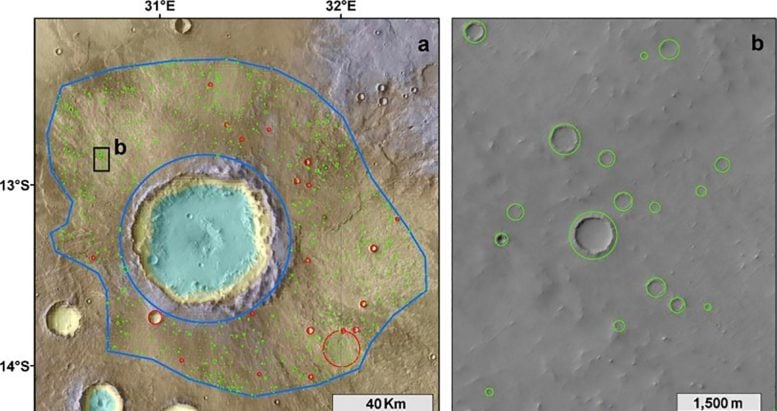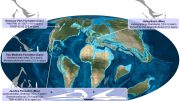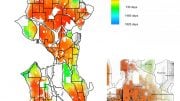
This image provides a perspective view of a triple crater in the ancient Martian highlands. Credit: ESA/DLR/FU Berlin
New research has confirmed the frequency of asteroid collisions that formed impact craters on Mars has been consistent over the past 600 million years.
Researchers analyzed over 500 Martian craters to understand their formation without finding significant variations in asteroid collision rates over millions of years. The study, using a crater detection algorithm, also suggests potential applications on the Moon and in fields like agriculture and nature preservation.
The study analyzed the formation of more than 500 large Martian craters using a crater detection algorithm previously developed at Curtin, which automatically counts the visible impact craters from a high-resolution image. The research, by Curtin University, was published in Earth and Planetary Science Letters.
Despite previous studies suggesting spikes in the frequency of asteroid collisions, lead researcher Dr. Anthony Lagain, from Curtin’s School of Earth and Planetary Sciences, said his research had found they did not vary much at all for many millions of years.

One of the 521 large craters that have been dated in the study. The formation age of this 40-km (25-mile) crater has been estimated using the number of small craters accumulated around it since the impact occurred. A portion of these small craters are shown on the right panel and all of them have been detected using the algorithm. In total, more than 1.2 million craters were used to date the Martian craters. Credit: Curtin University
Importance of Crater Counting in Planetary Science
Dr. Lagain said counting impact craters on a planetary surface was the only way to accurately date geological events, such as canyons, rivers, and volcanoes, and to predict when, and how big, future collisions would be.
“On Earth, the erosion of plate tectonics erases the history of our planet. Studying planetary bodies of our Solar System that still conserve their early geological history, such as Mars, helps us to understand the evolution of our planet,” Dr. Lagain said.
Insights From the Crater Detection Algorithm
“The crater detection algorithm provides us with a thorough understanding of the formation of impact craters including their size and quantity, and the timing and frequency of the asteroid collisions that made them.”
Past studies had suggested that there was a spike in the timing and frequency of asteroid collisions due to the production of debris, Dr. Lagain said.
“When big bodies smash into each other, they break into pieces or debris, which is thought to have an effect on the creation of impact craters,” Dr. Lagain said.
“Our study shows it is unlikely that debris resulted in any changes to the formation of impact craters on planetary surfaces.”
Extending Crater Analysis to the Moon
Co-author and leader of the team that created the algorithm, Professor Gretchen Benedix, said the algorithm could also be adapted to work on other planetary surfaces, including the Moon.
“The formation of thousands of lunar craters can now be dated automatically, and their formation frequency analyzed at a higher resolution to investigate their evolution,” Professor Benedix said.
“This will provide us with valuable information that could have future practical applications in nature preservation and agriculture, such as the detection of bushfires and classifying land use.”
Reference: “Has the impact flux of small and large asteroids varied through time on Mars, the Earth and the Moon?” by Anthony Lagain, Mikhail Kreslavsky, David Baratoux, Yebo Liu, Hadrien Devillepoix, Philip Bland, Gretchen K. Benedix, Luc S. Doucet and Konstantinos Servis, 7 January 2022, Earth and Planetary Science Letters.
DOI: 10.1016/j.epsl.2021.117362









He we go again those are lighting strike craters.
How are they determining their dating and impact timeline?
At this point in our understanding of the Martian geology, it seems that this algorithm would be based more on guess and conjecture, than fact based data.
Incorrect. This is literally the only model you have. On YT is an illuminating documentary called The Lightning Scarred Planet Mars that provides a demonstrably compelling and intelligent model for electrical arcing, showing side by side Mars to lab comparisons. Once you see that, then all these sorts of articles just start sounding absurd because they either continue to parrot the model that simply is not correct or they knowingly mislead the reader.
Sounds like someone believes in alternative realities rather than what is true. I’ve seen your “so-called” documentary and was surprised by the shear volume of sudo-science proclaiming to be fact. The truth is; ” we don’t know” , and everything else is conjecture by some who do that for a living but it does not make it fact!